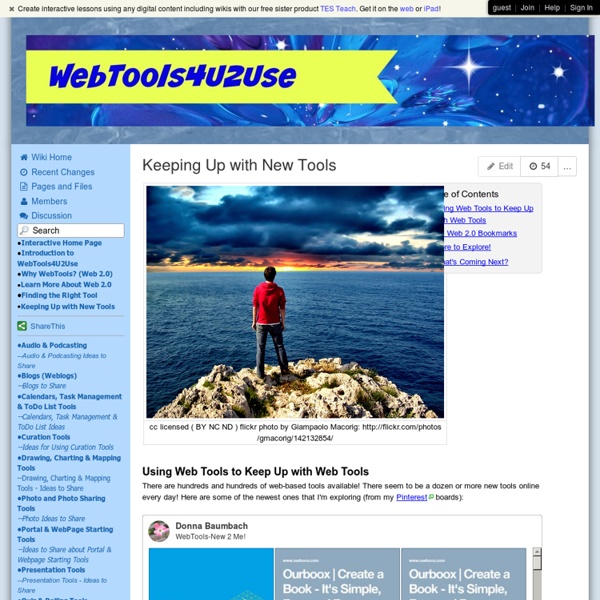14. Web 2.0 tools and beyond – 23 teaching things
Thing14 is about using Web 2.0 tools to produce information such as blogs, wikis, podcasts and media sharing, rather than just consuming it. In this Thing we talk about the pedagogy using Web 2.0 tools and beyond. We share some resources about Web 2.0 tools. What are Web 2.0 tools? Web 2.0 tools are online software and web-based services that let users create, collaborate, edit and share content online. Believe it or not, you have already been using Web 2.0 tools: creating an online blog (Thing 4), writing in the cloud (Thing 6, 7 and 8) and creating your own digital resource (Thing 9, 10, 11 and 12). Pedagogy for Web 2.0 tools As you plan how to use digital tools to enhance and improve students’ learning, Dr Ruben Puentedura’s SAMR model is helpful. Teachers need to consider how, why and when we use digital tools in the classroom. As digital tools open up opportunities for new ways of teaching and learning, what other skills do we need to teach? Web 2.0 tools for thinking Try this
Free Technology for Teachers
Pablo by Buffer - Design engaging images for your social media posts in under 30 seconds
Best Websites for Teaching & Learning
Best Websites for Teaching & Learning honors websites, tools, and resources of exceptional value to inquiry-based teaching and learning. Sites recognized foster the qualities of innovation, creativity, active participation, and collaboration. They are free, web-based sites that are user friendly and encourage a community of learners to explore and discover. The Landmark Websites are honored due to their exemplary histories of authoritative, dynamic content and curricular relevance. Landmark Websites for Teaching & Learning 2018-2019 Best Websites for Teaching & Learning Committee Stacy Brown Elizabeth Kahn Joy Millam Maria Muhlbauer Floyd Pentlin Leslie Preddy Kathryn Salmela Deborah Schiano Karen Scott Krista Welz Sherry Gick, Chair Phoebe Warmack, Board Liaison Jennifer Habley, Staff Liaison
The Cybrarian’s Web an Information Today, Inc. Book
engagedmediasolutions
A couple weeks ago I shared Part 1 of this four part series. That is all about how to use Canva in meaningful ways. Today I am excited to share Part 2! In this post, you will find five ways to use Canva in your library and classroom instruction. Buckle up and get ready to be inspired to use Canva in your library and classroom! A super easy and fun way to get students engaged is to make blank bookmark templates in Canva for students to design. You can find bookmark templates in Canva here. Design Thinking empowers students to develop new, innovative solutions to the problem at hand. You can find infographic templates in Canva here. This one is perfect to implement in the new school year! You can find presentation templates in Canva here. You can find photo collage templates in Canva here. Want to spice up your learning activities? Find learning activity templates in Canva here. There you have it! How do you use or plan to use Canva in your instruction? Part 3 Coming Soon! All my best, Brianna
Best Applications For Annotating Websites
I’m always on the look-out for web tools that can mimc a key instructional strategy I use with students in the classroom — having them use post-it notes to annotate books or articles so they can demonstrate their use of reading strategies (asking questions, making connections, etc.). I thought it would a good subject for another “The Best…” list. In order to make this list, it had to be available free-of-charge, be accessible to English Language Learners, and not require any downloads of any kind. Here are my choices for The Best Applications For Annotating Websites (not in order of preference): A.nnotate is the newest addition to this list. Rooh It! I’d like to highlight a couple of great features, though. The only negative I see is that it looks a little “busy” — English Language Learners could be a bit confused by all the initial options and text. Good News, Bad News & Good News On Website Annotation Tools Could “Microsoft Edge” Be The Magic Bullet For Annotating Websites? Related
Home
EDU 609 - Antioch University Seattle School Library Certification Program
Helen Adams, a former Wisconsin school librarian and technology coordinator, is currently an onlineinstructor in the School Library Media Endorsement Program of Antioch University-Seattle. Helen's published works include numerous article in professional journals. Additionally, she has written Protecting Intellectual Freedom and Privacy in Your School Library (Libraries Unlimited 2013), Ensuring Intellectual Freedom and Access to Information in the School Library Media Program (Libraries Unlimited 2008), Privacy in the 21st Century: Issues for Public, School, and Academic Libraries (co-author, Libraries Unlimited 2005), and is a contributor to the forthcoming The Many Faces in School Library Leadership , 2nd edition (Libraries Unlimited 2017). A former AASL President in 2001-2002, she is currently a member of the ALA Intellectual Freedom Committee, the ALA Privacy Subcommittee, the Knowledge Quest Advisory Board, the ALA American Libraries Advisory Board, and the ALA Nominating Committee.



